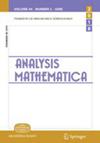局部核算子子代数的逆闭性
IF 0.5
3区 数学
Q3 MATHEMATICS
引用次数: 0
摘要
设X是Banach空间,T是作用于lp的有界线性算子(ℤc、 X),1≤p≤∞。如果算子T可以表示为$${(Tx)_k}=\sum\limits_{m\in{\mathbb{Z}^c}}{b_{km}}{x_{k-m}}},\quad k\in{\mathbb{Z}^ c},$$其中bkm:x→ X是核能,$${S}_1}}}{\beta_m},quad k,m\in{\mathbb{Z}^c},$$\(\left{S}_1}}}\)是核范数,β∈l1(ℤcℂ) 或β∈l1,g(ℤcℂ), g是ℤc.建立了如果T是局部核的,并且算子1+T是可逆的,那么逆算子(1+T)−1的形式为1+T1,其中T1也是局部核的。此结果是针对运算符在Lp中操作的情况而改进的(ℝcℂ).本文章由计算机程序翻译,如有差异,请以英文原文为准。
Inverse-closedness of the subalgebra of locally nuclear operators
Let X be a Banach space and T be a bounded linear operator acting in lp(ℤc,X), 1 ≤ p ≤ ∞. The operator T is called locally nuclear if it can be represented in the form
$${(Tx)_k} = \sum\limits_{m \in {\mathbb{Z}^c}} {{b_{km}}} {x_{k - m}},\quad k \in {\mathbb{Z}^c},$$
where bkm: X → X are nuclear,
$${\left\| {{b_{km}}} \right\|_{{\mathfrak{S}_1}}} \le {\beta _m},\quad k,m \in {\mathbb{Z}^c},$$
\(\left\|\cdot\right\|{_{{\mathfrak{S}_1}}}\) is the nuclear norm, β ∈ l1(ℤc,ℂ) or β ∈ l1,g(ℤc,ℂ), and g is an appropriate weight on ℤc. It is established that if T is locally nuclear and the operator 1 + T is invertible, then the inverse operator (1 + T)−1 has the form 1 + T1, where T1 is also locally nuclear. This result is refined for the case of operators acting in Lp (ℝc,ℂ).
求助全文
通过发布文献求助,成功后即可免费获取论文全文。
去求助
来源期刊

Analysis Mathematica
MATHEMATICS-
CiteScore
1.00
自引率
14.30%
发文量
54
审稿时长
>12 weeks
期刊介绍:
Traditionally the emphasis of Analysis Mathematica is classical analysis, including real functions (MSC 2010: 26xx), measure and integration (28xx), functions of a complex variable (30xx), special functions (33xx), sequences, series, summability (40xx), approximations and expansions (41xx).
The scope also includes potential theory (31xx), several complex variables and analytic spaces (32xx), harmonic analysis on Euclidean spaces (42xx), abstract harmonic analysis (43xx).
The journal willingly considers papers in difference and functional equations (39xx), functional analysis (46xx), operator theory (47xx), analysis on topological groups and metric spaces, matrix analysis, discrete versions of topics in analysis, convex and geometric analysis and the interplay between geometry and analysis.
 求助内容:
求助内容: 应助结果提醒方式:
应助结果提醒方式:


